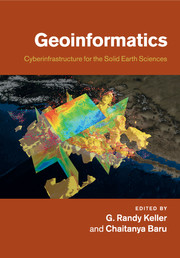Book contents
- Frontmatter
- Contents
- List of contributors
- Preface
- Introduction
- Part I Case studies from other disciplines
- Part II Modeling software and community codes
- Part III Visualization and data representation
- 8 Visualization of seismic model data
- 9 The UNAVCO GEON Integrated Data Viewer for exploration, analysis, and integration of geoscience data
- Part IV Knowledge management and data integration
- Part V Web services and scientific workflows
- Part VI Emerging international and other efforts
- Index
- Plate section
- References
9 - The UNAVCO GEON Integrated Data Viewer for exploration, analysis, and integration of geoscience data
from Part III - Visualization and data representation
Published online by Cambridge University Press: 25 October 2011
- Frontmatter
- Contents
- List of contributors
- Preface
- Introduction
- Part I Case studies from other disciplines
- Part II Modeling software and community codes
- Part III Visualization and data representation
- 8 Visualization of seismic model data
- 9 The UNAVCO GEON Integrated Data Viewer for exploration, analysis, and integration of geoscience data
- Part IV Knowledge management and data integration
- Part V Web services and scientific workflows
- Part VI Emerging international and other efforts
- Index
- Plate section
- References
Summary
Introduction
Modern geoscience data, like the Earth that they represent, often are 3-D and time-varying, with complexity on all length scales. Finding and studying significant features in such data is greatly improved with new approaches that use interactive 3-D visualizations.
As part of the Geosciences Network (GEON) development efforts, UNAVCO developed the GEON Integrated Data Viewer (IDV), a research-quality application for interactive 3-D display and analysis of geoscience data. The GEON IDV is designed to meet the challenge of investigating complex, multivariate, time-varying geoscience data (Meertens and Wier, 2007; Meertens et al., 2005; Meertens et al., 2006).
The Geosciences Network is a multi-institutional NSF ITR (Information Technology Research) project, and a scientist-centered cyberinfrastructure initiative that provides earth scientists with an array of tools, including data access and integration mechanisms, computational resources, and software for analysis, modeling, and visualization. Needing a powerful tool for visualization and integration of earth science data, one path the GEON team chose was to build on the UCAR (University Corporation for Atmospheric Research)/Unidata Integrated Data Viewer, an open-source, meteorologically oriented, platform-independent application for visualization and analysis. Unidata's IDV brings together the ability to display and work with satellite imagery, gridded data, surface observations, balloon soundings, NWS WSR-88D Level II and Level III RADAR data, and NOAA National Profiler Network data, all within a unified interface.
Information
- Type
- Chapter
- Information
- GeoinformaticsCyberinfrastructure for the Solid Earth Sciences, pp. 131 - 142Publisher: Cambridge University PressPrint publication year: 2011
